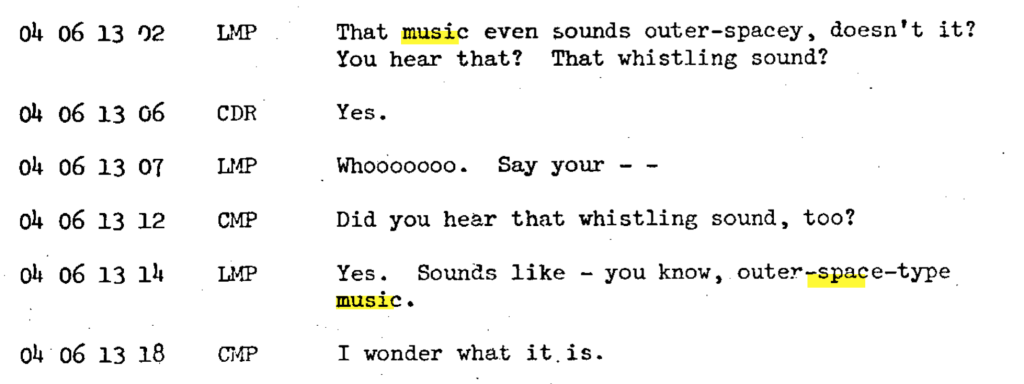Science and history can serve as great prompts for creative music making! The following excerpt from transcripts of the Apollo 10 mission, references “outer-space-type” music, which could be a great starting point for young people to create their own “space music.”
 Photo by NASA/Goddard Space Flight Center Scientific Visualization Studio
Photo by NASA/Goddard Space Flight Center Scientific Visualization Studio
Take a look at the following excerpt of conversation between Lunar Module Pilot (LMP) Eugene A. Cernan, Commander (CDR) Thomas P. Stafford, and Command Module Pilot (CMP) John W. Young:
While people debate whether the sound was radio interference, the conversation can serve as an invitation to be imaginative about what that music would have sounded like.
Here’s one way to set up this type of creative project:
- Give the young person a copy of this conversation to read (you might want to have multiple people read aloud, playing each role)
- Pose the following question: What do you imagine that outer-space-type music might sound like?
- Invite the young person to create their own outer-space-type music
- You might want to encourage the “composer” to spend some time exploring lots of different sounds that could be used for the music.
- If working with multiple young people it would be great to have them work individually or in small groups to create their own versions of outer-space-type music and then share their music with each other.
- After they have composed their music, you might consider sharing the actual footage of the sounds with the young composers. We think sharing this before the music creation can end up constraining their ideas in relation to what they heard.
You can watch and listen to excerpts of documentary footage from “NASA’s Unexplained Files” that include the actual sounds and conversation from the Apollo 10 mission along with commentary (along with a bit over-dramatic narration)
Here are some interesting connections and extensions to this project:
Sounds of Space
You might expand this project to include the creation of music that uses recordings of sounds from space or is accompanied by these sounds. For instance, some of these recordings could be used as samples and manipulated in software such as Garageband, Soundation, or any number of other music creation applications.
“Sounds of Space” collected by University of Iowa instruments on various spacecraft.
The BBC and Dr. Lucie Green share the Sounds of Space
Dr. Fiorella Terenzi’s “Acoustic Astronomy: The sound of the Sounds of the Universe project
Related music created or performed by others
The Kronos Quartet performed music by composer Terry Riley that included radio waves from the solar system.
Composer and accordionist Pauline Oliveros created the music Echoes from the Moon, which includes “sending out sound through the emptiness of space to be reflected back off the moon, our closest planetary companion.”
The website MusicSpace “celebrates music that is written for space exploration. Or is about space exploration. Or is played inspace. Or makes you feel like you are in space. Or is actually from space.”
Wikipedia entry on space-themed music.
NASA has a Space themed musical for young people, but we think it would be much more interesting and musically satisfying for young people to create their own original musicals!
Other related information and resources
Share with young people how NASA sent music into space to communicate with potential aliens.
Have young people consider the question: Is there sound in space?
Looking for helpful resources to facilitate composing?
Try these books [include affiliate links]! (These books are written for music educators but can be useful to anyone who wants to support young people’s music creation.)
Minds on music: Composition for creative and critical thinking – Michele Kaschub & Janice Smith
Composing our future: Preparing music educators to teach composition – Michele Kaschub & Janice Smith
Music outside the lines: Ideas for composing in K-12 classrooms – Maud Hickey
Musicianship: Composing in Band and Orchestra – Maud Hickey, Alexander Koops, Clint Randles, & David Stringham
Can I play you my song? The compositions and invented notations of children – Rena Upitis
